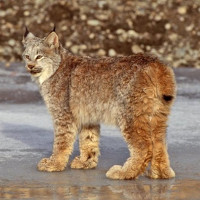 |
Red Lynx |
|
He is a wild animal |
Origin |
Between southern Canada and northern Mexico | |
Translation |
Francis Vandersteen |
| The possession of this animal is not authorized Royal Decree establishing the list of mammals not kept for production purposes that may be kept (M.B. 24.08.2009) |
| The Red Lynx, also known as Lynx bai, Chat sauvage in Quebecois French, Chat tigré in Cajun French and Bobcat in English, is a feline of the Lynx genus that lives in North America. With twelve recognized subspecies, its populations range from southern Canada to northern Mexico, encompassing most of the USA. This predator occupies a wide range of habitats, from woodlands to semi-deserts, including urban areas and swampy environments. The Red Lynx resembles the other three species of the Lynx genus, with ears crowned with a plume of black hair, a short tail and a swaying gait due to its very long hind legs. It does, however, have distinctive black bars on its front legs and a short tail with a black tip. It averages 90 cm from head to tail, and 50 cm at the shoulder. Its weight varies from 6 to 13 kilograms. The Red Lynx is capable of surviving long periods without eating, then swallowing large quantities of food when prey is abundant. During periods of dearth, it will often attack larger prey that will provide food for several days. The Red Lynx tracks its prey from ambush, then attacks it with a leap, or after a short chase. It prefers mammals weighing between 0.7 and 5.7 kg; its main prey varies from region to region: in the eastern USA, it prefers the snowshoe rabbit, while in the northern part of its range, it prefers the snowshoe hare. When these main prey species coexist, as in New England, they represent the primary food source. In more southerly regions, rabbits and hares are replaced by rats of the sigmodon genus. The main prey in Washington State is the Mountain Beaver, the Peccary in Texas and the Arctic Hare in Canada. The Red Lynx is an opportunistic species, and will change its diet without hesitation, unlike the more specialized Canadian Lynx. Research has shown that changes in diet correlate with declines in the Lynx's main prey species. The Red Lynx adjusts its hunting techniques to the size of its prey. With small animals, such as rodents, squirrels, birds, fish and insects, it will hunt in areas known to be abundant in prey, and will lie in wait for prey to approach before pouncing and seizing it with its claws. For slightly larger animals, such as rabbits and hares, it hides in the undergrowth and waits until its prey is less than 10 meters away, then pounces. Less commonly, it may feed on larger animals, such as foxes, minks, skunks, domestic dogs and cats, and occasionally attacks livestock and poultry. Although horses and large livestock are spared, it is a threat to small ruminants such as sheep and goats. According to the USDA's National Agricultural Statistics Service, Bobcats killed 11,100 sheep in 2004, accounting for 4.9% of sheep predation deaths. However, some deaths may be misidentified, not least because Bobcats also feed on animals killed by other predators. There are 12 recognized subspecies : Lynx rufus baileyi Merriam, 1890 - southwestern USA and northwestern Mexico Lynx rufus californicus Mearns, 1897 - California, western Sierra Nevada Lynx rufus escuinipae J. A. Allen, 1903 - central Mexico, extending north along the west coast of southern Sonora Lynx rufus fasciatus Rafinesque, 1817 - Oregon, Washington, western Cascade Range, northwestern California and southwestern British Columbia Lynx rufus floridanus Rafinesque, 1817 - southeastern USA and Mississippi Valley to southwest Missouri and southern Illinois Lynx rufus gigas Bangs, 1897 - northern New York to Nova Scotia and New Brunswick Lynx rufus oaxacensis Goodwin, 1963 - Oaxaca Lynx rufus pallescens Merriam, 1899 - northwestern USA and southern British Columbia, Alberta and Saskatchewan Lynx rufus peninsularis Thomas, 1898 - Baja California Lynx rufus rufus Schreber, 1777 - east-central USA Lynx rufus superiorensis Peterson and Downing, 1952 - Western Great Lakes, including Michigan, Wisconsin, southern Ontario and much of Minnesota Lynx rufus texensis J. A. Allen, 1895 - Western Louisiana, Texas, central Oklahoma and southern Tamaulipas, Nuevo Leon, and Coahuila |






 English (United Kingdom)
English (United Kingdom)